#look I do drafts and storyboards this is DESTROYING me
Text

Loooong time no post. Drew this way back I January but never posted it.
Since I didn't finish the Artober at all, I've been thinking about posting some drawings of Scarlet/Violet, as I've been playing those in the last months a lot. Maybe slowly warm up again to the "arctober" drawings at some point...
Won't promise anything though, animating in-betweens is currently destroying my sanity and time

#pkmn#pkmn fanart#pokemon#pokemon fanart#pkmn legends arceus#pkmn sv#pkmn scarvio#pkmn spoilers#pokemon sv#pokemon scarlet and violet#pokemon scarvi#miraidon#koraidon#origin dialga#origin palkia#pkmn la spoilers#legends arceus spoilers#legends arceus oc#pkmn sv oc#inbetweeners of the world you have my admiration and respect#also everyone else in the animation process#look I do drafts and storyboards this is DESTROYING me#maybe I'll draw more things when I manage to finish this awfully long scene of about 10 seconds long#at least I finally got my revenge against Probopass in a Tera Raid in scarlet#rambling in the tags#as usual
37 notes
·
View notes
Text
I finally finished the first* draft of my script
I revised some things since showing the moving storyboard last week, and I'm working on updating the drawings now. It's not formatted like a true proper script but I have all of the story elements written down.
Please let me know you guys think. Is there anywhere I could condense or further elaborate on? Is everything clear? Does the story have a good progression?
In-Between Mediums first draft
A hand is drawing on a tablet. It is drawing a character moving. A cell phone rings next to it, the hand moves to pick it up, and leaves the scene.
On the tablet screen, the character he was drawing (Aaron 2D) is maintaining the in-between pose of the walk cycle. He struggles to maintain his balance and falls over. Time passes, as indicated by the clock in the tablet’s taskbar.
Impatient and bored, the 2D Aaron is browsing the internet on a computer window, as if it were his personal computer. He scrolls through a website and an Advertisement appears reading “Bored? You want FUN? Click here for some fun”. 2D clicks the ad. The window flashes a virus-like creature before it glitches out and closes in his hands.
The screen shakes, as if there were an earthquake. He notices the folder icon on the taskbar starting to glow and pulsate.
Another crash and boom is heard, and a large virus emerges from the folder, with other smaller viruses flying out of it as well. Some of the viruses grab him and pull him into the folder, now open and sucking everything into it.
Inside the portal folder, there are many other folders floating around, labelled different things. Aaron grabs one folder and climbs in.
Inside, he sees a 3D doppelganger of himself. 3D Aaron is also fighting off the viruses. 2D goes to help him. They do a super fighting move where 3D grows using the scale tool, and he crushes the viruses. Satisfied and safe, they wave goodbye as 2D jumps back into the folder portal.
2D flies in the portal a bit, and he sees some viruses enter another folder. He follows them in and finds a Pixel version of Aaron fighting them. Near the portal entrance, 2D sees a pixel sword. He calls out to Pixel Aaron and tosses the weapon towards him. Pixel catches it and does a super fighting move of his own, reminiscent of an old video game. Slicing the viruses to bits with explosions and fanfare, he gives a thumbs up to 2D as he heads back into the portal.
Back inside, 2D sees a folder exit bursting at the seams with viruses. Concerned, he breaks through the blockade and into a world that is totally corrupted. After looking around, he sees a gaggle of viruses demolishing another version of Aaron, glitching out. Corrupted Aaron looks pleadingly at 2D, but it is too late to save him. Corrupted Aaron slowly points to the top corner of the screen to the big red X button. Reluctantly, 2D climbs up and hits the button. A new window appears.
“Save before closing?”
>Save
Exit without saving
2D looks down at his corrupted counterpart. His glitches get worse as the viruses tear into his body. He points to the second button and nods his head. Distraught but with no other choice, 2D pushes “Exit without saving”. As the entire world slowly fades to black, the viruses disappear. All that’s left of this world before 2D reenters the folder portal is the corrupted Aaron whispering “thank you” and fading away.
Determined to not lose another to this plague, 2D seeks the source of the viruses from within the portal. Looking up, he sees the downloads folder shaking and spitting out new viruses. 2D flies up the portal and into the folder, where he sees a rogue program, VIRUS.EXE, spawning new viruses. The program draws all of the viruses left in the computer together to create an Ultra Virus.
2D sprints towards the ultra Virus in an attempt to destroy it. The Virus dodges and slams 2D to the ground. In a chokehold, he is about to black out, but then the folder he emerged from shakes and launches 3 more Aaron’s towards the virus in a blur. 3D Aaron kicks it, Pixel slashes it, and the corrupted Aaron, alive and well, clobbers it with a massive punch.
Taken by surprise, the Ultra Virus releases its grip on 2D. Free and ready to finish the job, 2D Aaron unleashes his own special move by toggling his Onion Layers. Creating before and afterimages of himself, he pummels the Ultra Virus into the VIRUS.EXE program, and they both hurtle towards the trash bin. In one massive blow, all 4 Aaron’s push the viruses in, and they’re gone for good.
Satisfied, all of the doppelgangers say their goodbyes and jump back into the folders. 2D climbs back into his original program, dusts himself off, and gets back into position as he hears the footsteps of his artist walking back to his desk to continue the original drawing.
The artist scribbles on the screen some more before pausing. He presses the play button.
The drawing of Aaron does a little dance.
0 notes
Text
mp. reflection. 034
This week I’ve been learning a lot of new things about sound and music design. I also was working more on post-production and I find this very nice. It did cross my mind before that the production itself isn’t really my favourite thing but I do enjoy the planning stage and the post-production stage a lot.
For planning I think I always liked to explore different ideas and scenarios. I also love exploring different aesthetics and art styles, it’s hard for me to stick to one, that’s why I like to immerse myself in the pre-production because there is so many possibilities.
The production is boring and very tedious for me. I find it hard to focus on one thing because I want to see the finished product right away. This causes me to rush things.
Once I have my first draft and I can see the bigger picture, it is easier for me to judge what should be fixed. But my favourite part it destroying the first draft and rearranging things to fit the sound and to build the atmosphere of the film.
While doing the storyboard and animatic, since everything is very plain I find it hard to imagine how things will look like when it’s all finished. I think I have a more of a live-action approach to making films, that’s why I tend to rearrange shots during the pre-production stage simply because seeing the finished look of the scene I can judge where it should go better.
That being said, I don’t know how much of this film I will rearrange yet, but I already have some ideas how to make the split scene more engaging to watch. So hopefully I will be able to achieve that.
0 notes
Text
SUMMARY
Fifty years after a nuclear holocaust, mankind is decimated and the surviving nations—the western-influenced Market and the Russian-influenced Confederation—have agreed to outlaw traditional open war. In their place, disputes are settled with gladiator-style matches between giant robots operated by pilots called “robot jox” who are contracted to fight ten matches. The Confederation champion is Alexander (Paul Koslo), who has killed his last nine opponents thanks in part to a spy in the Market leaking information to the Confederation. The Market’s champion, Achilles (Gary Graham) has won nine fights and will fight his final match against Alexander for the territory of Alaska. Achilles is supported by robot designer “Doc” Matsumoto (Danny Kamekona) and strategist Tex Conway (Michael Alldredge), the only jox to win all ten of his contract fights.

As Achilles gets the upper hand in the match, Alexander launches a rocket fist at him. The projectile goes out of control and heads toward the bleachers. Achilles intercepts the projectile but his robot takes the full force of the impact and is knocked into the crowd, killing over 300 people. The referees declare the match a draw and order a rematch, but Achilles, shaken by what happened, declares this was his contractual tenth match and announces his retirement. He goes to live with his brother Philip and his family, and finds he is publicly branded a traitor and a coward. Meanwhile, a new jox is chosen to face Alexander, a genetically engineered “gen jox” named Athena (Anne-Marie Johnson), who is the first female jox. Worried for Athena and attracted to her, Achilles returns to the Market and agrees to fight Alexander again, infuriating Athena.

As Achilles’ robot is rebuilt, Matsumoto refuses to divulge any knowledge of its new weapons so it cannot be leaked by the spy, and Conway confides in Achilles he believes Matsumoto is the spy. Conway confronts Matsumoto in his office. Matsumoto reveals he has analyzed Conway’s final fight and deduced that the “lucky” laser hit Conway claims allowed him to defeat a clearly superior opponent was in fact deliberately aimed; Matsumoto accuses Conway of being a Confederation agent. Conway confesses and shoots Matsumoto, who secretly records the deed as part of the mission briefing. Conway informs the Market leadership that Matsumoto was the spy. On the day of the fight Athena drugs Achilles and steals his jox suit to commandeer the robot. Unable to stop the fight once she takes the field, the Market decides to support her. While watching Matsumoto’s briefing on the robot’s new weaponry, the footage of Conway killing Matsumoto is played and Conway jumps down the robot’s elevator shaft to his death.

Alexander takes the field against Athena. Athena takes the early advantage, but Alexander overpowers her and incapacitates the robot. The fight is declared in Alexander’s favor and referees order him to stand down. Achilles arrives on the field and takes over the robot from Athena while Alexander smashes the referee hovercraft; the two jox stand to continue the fight. Both robots take to the air and a short space battle ensues. Alexander critically damages Achilles’ robot, forcing him to crash land and flee for cover to the arm of Alexander’s robot Athena sliced off earlier in the fight. Achilles hotwires the arm to launch its fist at Alexander, destroying his robot. Alexander emerges from the wreckage and the two battle with poles before Achilles finally convinces Alexander a match does not have to end with the death of a jock. Alexander throws down his weapon, and they salute each other with the jox’s traditional “crash and burn” fist bump.

DEVELOPMENT
Gordon conceived Robot Jox while making Dolls in Rome. “I’m a big fan of the Japanese Transformer toys,” he explained from his office, which overlooks Sunset Boulevard. “While there have been animated cartoons based on these giant robots, no one has ever attempted a live-action feature about them. It struck me that it was a natural fantasy for the big screen-and a terrific opportunity to take advantage of the special effects that are available today.”

Steve Burg’s 1986 concept art
Gordon approached science-fiction writer Joe Haldeman to write a screenplay based on Gordon’s original story itself based on the story of Achilles from Homer’s Iliad-having worked with him two years prior on an ambitious stage adaptation of Haldeman’s most celebrated book, The Forever War: Dennis Paoli (co-author of Gordon’s Re-Animator and From Beyond) put the final draft through various rewrites.
“Joe is part of an Air Force think tank to develop weaponry for the future,” explained Gordon, “so he was able to incorporate a lot of actual existing technology into the script and to hypothesize where it might all lead. Then we started storyboarding the film. The reaction to Dave’s footage was excellent, and Charlie was able to get the project rolling on a projected $10 million budget-a huge budget for an Empire film. I think Charlie saw it as Empire’s chance to move up into larger-budget films.”
“Haldeman did 11 drafts of the script,” the director recalls. “Joe’s experience in Vietnam was helpful here because the story’s about our future, 50 years after an atomic war. The world is basically broken down into two superpowers: The Market, which is like the Common Market except that Japan and the United States are part of it, and the Confederation, which is everybody else. Earth has vowed no war will ever take place again, so international disputes are settled by single combat between pilots of huge robots.” These pilots are called robot jockeys or robot jocks
The sequence, using robots designed by Kevin Altieri, was storyboarded by Altieri from the prologue to the script by science fiction writer Joe Haldeman, set in a snowscape where a heavy fog covers an apparent “elephants’ graveyard” of broken, battered robots, the fallen warriors of a robotic battlefield. Here and there among the shells, fires sputter near the latest casualties while a big, menacing robot stands over its victim.
“I thought it turned out very well,” said Allen of the test footage. “The style is quite different from anything else we did subsequently because it was all shot interior while everything else has been done exterior. It didn’t splice together perfectly because it depended upon live-action which hadn’t been shot.”
PRE-PRODUCTION
Six months passed while Empire continued efforts to raise financing for the film while at the same time revising the effects complexities of the script to bring them in line with budget realities, mostly by simplifying the robot action. During these delays designer Altieri left the production to accept work as a full-time director at DIC Animation Studios.
Gordon said he brought Cobb into the project “to bring a real sense of believable technology to the robots, so they could be something an audience could accept as a reality as opposed to a cartoon show. Cobb designs things that could actually work,” said Gordon. “What we ended up with was a look that was different from the look of the Japanese toys. It’s very utilitarian and it looks big, like it has the power to do what it has to do.”

Cobb explained that when he was approached by Gordon to work on ROBOT JOX he was already committed to another project and could only work on weekends. “When I left, I told them they should make Steve Burg production designer or give him the clout of production designer because he was the only person that knew how the robots went together and was the only person that could police the construction,” said Cobb. “They just walked all over him. Eventually it was wrenched out of his hands. Everything went to pot when he left. The designs got really confused. The final shape and form of the film has obviously had problems, too.”
“I was most intrigued to design the cabs and how the interactive body motions were translated by waldos to the entire robot. I was trying to think of a reason for transformation. If it could translate into different modes of fighting, that might make sense. The idea really is silly, of course, but I wanted to keep it believable and then over and above it all, it’s humorous. It’s not a serious picture, and it isn’t meant to be.”
This slideshow requires JavaScript.
Cobb was also asked to design robotic parts made of heavy-duty plastic (with metal armatures underneath) which special FX supervisor David Allen could reshape, using different models for different shots during the film’s major transformation sequences. Another Cobb-assisted movie is Stuart Gordon’s Robot Jox. “Again, that was in my conceptual design mode, so I basically opted to do all the key technology and moved on. Steve Burg was involved, and carried out many of my designs. We wanted a kind of non-Japanese version of a Transformer robot, which is very, very clever technologically speaking. We weren’t going to have them turn into semi-trucks or something, but we were going to have them break apart and operate in different functions and modes. I always liked the idea where the entire head became a little aircraft. I believe that has been changed-now the whole robot flies and changes.
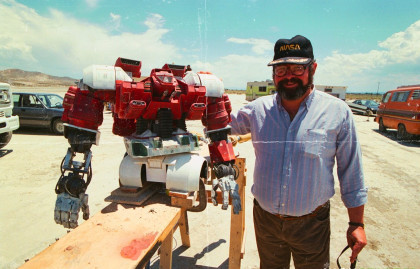
According to Allen, Cobb came up with a new look for Achilles and Alexander, the main robojock pilots, their robots, and a few sets, including a gantry and silo. When the project encountered more delays, Cobb too, departed. “I suspect that payments to Ron started to flag,” said Allen. “There was sort of a painless transition. Ron left Steve Burg in charge to do the refinements and subsequent modifications.”
Steve Bury was brought in to assist Cobb with the robot detailing, since Cobb had a limited amount of time to devote to the project. “We were constantly referring to Ron’s drawings, and Steve continued to report back to Ron to show him what he was doing and to get Ron’s approval. As a matter of fact, Ron and Steve hit it off so well that they’ve worked together ever since.”

LIVE ACTION PHOTOGRAPHY
Robot Jox began principal photography at Empire’s Rome facilities in January 1987, and wrapped in April. Gordon then turned over the post-production effects to Allen, who had selected El Mirage, a dry lake bed near the Mojave Desert, as the site for filming of the live-action robot skirmishes. (Some stop-motion work would be done at Allen’s Burbank studios; the live-action filming made use of the 5-foot, 50-pound cable-controlled models of Achilles and Alexander.)
“There wasn’t too much choice as far as shooting outdoors because Empire didn’t own a local stage we could work on,” Allen explained. “And even then it would have to have been huge; we would have had to hang and paint a cyclorama and then put tables out and light everything artificially. We would have been into a tremendous set rental situation over an extended period of time, which would have been a huge cash drain.”
El Mirage was chosen for its brilliant blue skies and unobstructed panorama, but the year of on-again, offagain shooting that transpired-Allen and his crew would make a total of three trips out to the desert location proved to be anything but smooth sailing. The weather was so temperamental Allen considered it a good day if he got two or three good shots in the can.
The heat wasn’t so bad, but as we were in a geothermally unstable area, we were at the mercy of the elements,” Allen said. “We had to contend daily with clouds, rain, dust storms and hellishly high winds-our outhouse got blown over constantly. Sometimes the dust was so bad you couldn’t see in front of you. When that happened, we’d go back to the motel or drive back to L.A. When it rained the lake bed would fill up and our cars were in danger of getting stuck.”
Numerous delays caused by the weather-and requests made by Gordon for additional effects-made location shooting more costly than Empire budgeted for. Still, Allen bristles at the suggestion that his unit work might have set the film back. The location shooting was probably more expensive than Empire expected, yeah. However the problem wasn’t that we were breaking the bank but that we weren’t getting money sent to us regularly enough. If by week four we didn’t have a check, we had to go back to L.A. Rain or shine I still had to put up 10 or 12 guys in a motel.”

David Allen
SPECIAL EFFECTS PHOTOGRAPHY
With the designs set, the robots were finally transferred from the drawing table into three-dimensional models, constructed in two sizes: a stop motion size of about 20 inches tall and a larger cable-articulated miniature, closer to 50 inches high. Allen pointed out that the robot miniatures were particularly difficult to build because their joints had to be cosmetic as well as practical.“A robot doesn’t have implied’ joints like a foam rubber model,” said Allen. “It has actual working interstices: the hinges and swivels and all the hydraulics and the pistons have to be tracked. It isn’t like rubber that just mushes out of its own way. If you don’t design it right, the joints will all freeze up and lock. A robot can look good and be totally musclebound or joint bound.”
“The transformations sort of suffered due to the realities of the schedule and the budget,” said Burg. “The changes were generally not that extensive. The rocket mode, for example, had some wings pulled out and cockpits reoriented, but it was still recognizable as being the same thing, whereas with some of the TRANSFORMERS cartoons, it looks completely different. That would have been possible, but it would have taken an enormous amount of time to figure it out cleverly and would have taken a lot more resources to execute.”
Dennis Gordon, a long-time Allen associate, supervised the construction of the robot miniatures for Allen. Ron Thornton was brought in to head another construction team, and Mark Goldberg and Patrick Cox of the Local Motion Company were hired to build the cable-activated controls and armatures. Mark Rappaport built many of the robot’s weapons. Construction crews of up to twenty craftsmen worked for many months to complete the miniatures.
During this time, Allen was working full-time for ILM in San Rafael on BATTERIES NOT INCLUDED, a four month assignment he had accepted during one of the many production delays on ROBOT JOX. The ILM work stretched into a full year, keeping Allen away from his shop except for weekend visits to supervise the progress of building the ROBOT JOX miniatures. Allen compared overseeing the consortium of effects people at work to “managing D-Day.” During the weekend visits to his LA studio, Allen also completed stop-motion work for Gordon’s DOLLS.
Good actors are essential in selling special effects, making them seem believable, and Gordon said he felt that his cast was very good at “being able to create that sense of combat, one-on-one, which depends on the actors involved to be able to react with each other and play off of each other. The feeling that we were going for was something like ROCKY,” said Gordon. “There are real ups and downs in these battles and real emotional reactions to things that are going on. The robots are basically tools and weapons that are carrying out the war of these men.
This slideshow requires JavaScript.
David Allen began post-production work on the carefully storyboarded robot battles, filming stop-motion at his studio and taking a crew out to a dry lake bed in El Mirage, near the Mojave desert, to film the large cable-activated robots live. Allen executed the stop-motion work with Paul Jessel, who animated the Achilles robot after Athena takes control.
Said Allen about working with Gordon, “Stuart is a person who showed himself to be quite decided about things, but he doesn’t dig in his heels. He accepts realities when .he’s satisfied that what he wants is impractical or not possible. I had a pretty free hand considering what I imagine Stuart is like on a set where he would usually be expecting to control his movies—that’s what any director expects to do. He was pretty good about letting us work in a loose kind of way. Of course, the [story]boards are very important. I don’t deviate from them too much unless I have to or I feel I can improve them or in some cases I just feel they are not very filmic. My changes have usually been appreciated rather than resented. I think we have a good relationship compared to the horror stories I often hear about with other directors.”
“Conceptually, filming there was a wonderful idea but, in reality, it turned into a huge ordeal for Dave’s crew because they were shooting out there for almost a year, completely at the mercy of the desert. When they came back, they all looked like Lawrence of Arabia.”
Additional robot weaponry includes cannons, machine guns and a Smart missile, on which is mounted a video camera for point of-view shots. For hand-to-hand combat, there are saws, drills and a magnesium flare which can suddenly blind an opponent.
youtube
But, says Gordon, “the human story must be the center of it all. No matter how great your FX are, if the audience doesn’t care about the people, then there’s no movie. That’s why I was drawn to the story of Achilles, the warrior who doesn’t want to fight anymore but is forced back into it because of his lover’s death. That’s the center of ours as well, though we’ve put it into science-fiction terms.”
Along with some stop-motion FX added later, Allen and his crew shot on location in the Mojave Desert utilizing large models for these mechanical effects; others were used for pyrotechnic explosions, while some doubled as “stunt robots” for shots in which they couldn’t destroy their carefully detailed models.
“By shooting in Death Valley, David was able to do extensive foreground miniature work, as opposed to doing it optically in post-production,” explains the director. “So most of the effects work was done in the camera, which gives it a very realistic, seamless look, because you’re seeing real mountains, sky and sunlight behind these robots.” This technique also offered the filmmakers a tremendous depth of field, keeping both the foreground and background in focus.
The live location shooting of the big miniature robots at El Mirage proved to be the biggest headache for Allen. When the location work cost Empire more than expected, Allen’s crew had to pack up and leave until more funds became available. All in all, Allen and his crew made three extended trips out into the desert. “I think if you took all the periods and added them up, we were out there for at least six or seven months,” said Allen. “That’s a long time to have a second unit crew on location. We made a very large commitment to that decision. It was a decision dictated by my recommendation, but also by practicalities.” The alternative would have been to shoot in an enormous warehouse or hanger with cycloramas, which would have been an even more expensive proposition for Empire, according to Allen.
“It takes a certain daring to shoot outdoors,” said Allen about the decision. “That’s why movies were made indoors for thirty years, because of the pressures of the industry to force predictability and control on the product. There were a lot of problems in El Mirage. We underestimated those problems.”
According to Gordon, one of the reasons the effects are taking so long is that Allen is shooting in sunlight out in the desert to incorporate real mountains and skies as a backdrop. The vastness of the desert is being used to combine the miniature robots with vast cheering throngs of spectators by shooting the cable-controlled models up close with a stadium set far in the background.
Allen is also shooting background plates for stop-motion work to be completed at his own studio. “I think the effects are really going to blow people’s minds,” said Gordon. “Although this is Empire’s largest budget, anyone else attempting this picture would want to budget three times as much.”
Gordon also pegged the film’s delay to the time-consuming special effects techniques being used to bring the story’s giant, transforming, fighting robots to life. The work, supervised by Oscar nominee David Allen, is said to be spectacular by those who viewed a product reel of footage shown by Empire at the American Film Market earlier this year. To realize the film’s complex effects action inexpensively, Allen wedded today’s sophisticated puppet technology to the low-budget effects techniques used by Howard and Theodore Lydecker on the Republic serials of the ’40s, filming the robots live against real backdrops.
This slideshow requires JavaScript.
“It’s an approach that I don’t think anyone would attempt unless they were looking at this as we were—from a very low budget,” said Gordon about reviving the Lydecker approach. “Rather than light a miniature on a stage, they would take the miniature outdoors and light it with sunlight, using real sky and real clouds. It gives the miniature work greater realism. The effect is seamless because it is done in the camera.”
Gordon thinks audiences will be able to notice the difference from the blue screen optical compositing techniques that have become commonplace in effects films. “I think audiences are starting to get wise to those techniques and are able to spot them and know exactly what you’re doing,” he said. “By going back to these older techniques, our effects have a freshness about them.”
Allen and his crew spent over a year in the desert shooting the film’s robot scenes using natural sunlight, painstakingly matching the variable lighting conditions for sequences filmed over a prolonged period of time. At the mercy of the elements, the crew endured wind, rain and sandstorms which often made the shooting a waiting game. Beside the weather, the financial climate at Empire resulted in its own delays. “At one point they had to shut down production and pull Allen and his crew out of the desert until the cash flow improved,” said Gordon.
Allen accomplished most of the scenes of robot warfare live, using cable-controlled models, although stop-motion is used for some scenes. He has a second set of robots that are in a smaller scale which he uses for stop-motion,” said Gordon. “When he’s not able to get the large ones to do it, he uses stop-motion. One of the things that I am amazed at is that he’s able to meld the two in terms of being able to go from a stop motion shot to a puppeted shot. I don’t think the audience will be able to tell the difference in most of the cases. It’s a wonderful blend.”
Allen was pleased with the realism provided by the natural lighting and backdrops, but using a natural sky meant that the sky was always changing, making it sometimes difficult to match shots. And the sky at El Mirage was like Mark Twain’s comment about the Hawaiian Islands: “If you don’t like the weather, wait a few minutes and it’ll change.” Noted Allen dryly, the weather almost always seemed to get worse on any given day rather than better.
This slideshow requires JavaScript.
Allen’s right-hand man on the shoot was associate effects director Paul Gentry. Ray Goode served as effects crew foreman and pryotechnician Joe Viskocil handled the fire and explosions. Winds proved especially bedeviling for the numerous shots requiring pyro effects, blowing the fire and smoke hysterically, giving away the small scale of the miniatures. The wind also blew sand off the elevated tables that the miniatures were filmed on and into the faces of the cable operators and camera crew. The difficult shoot was exhausting to everyone on the crew. Seemingly simple sequences would take hours to get on film because the process by which the robots were manipulated had to be hidden and their movements painstakingly detailed and adjusted. But Allen is very pleased with the results that were achieved.
“A major studio could not have afforded to put up a second unit working in the conditions under which we produced these shots,” said Allen. “A lot of days we simply couldn’t do anything and had to sit it out. It would be ruinously expensive to work that way for a major studio. For them, it would have been cheaper to work indoors. But for Empire it would have been much more expensive because they were not committed to the union way of doing things. To put a second unit out under those conditions, you would have to have a lunch wagon and a guard and all the facilities and amenities. We had my old R.V. and we were like a bunch of ragtag Eagle Scouters practically.”
Looking back on the years of work on ROBOT JOX, Allen remembered with some irony his first conversation with Empire chief Charles Band about ROBOT JOX, indicating the naivete with which Empire entered into the complex effects project.

Joe Haldeman
Interview with screenwriter Joe Haldeman
What kind of working relationship did you have with Stuart Gordon?
Joe Haldeman: I enjoy working with Stuart because he’s one of the best administrators I’ve ever seen in the arts. He and I had many pretty good-natured arguments over what the movie was going to be about, and about what science fiction was supposed to do. He usually won, being the director. We identified the problem without actually solving it-I was trying to make an adult movie that children would enjoy, and he was trying to make a children’s movie that adults would enjoy. Those are two really different kinds of movies, and I guess we never did resolve them.
How did you get involved?
Joe Haldeman: Stuart called me. He’d had two successes with From Beyond and ReAnimator, and the producer gave him more or less carte blanche. He wanted to do a hard SF movie, so he called me up and he said, “I don’t have much money, but how would you like to write a movie that actually gets made?”
And I said, “Yeah!” So, he said, “What I want to do is a science-fiction version of The Iliad.” I said, “Great,” and he said, “I’ll send you a couple-page outline.” So, I get this outline, it’s pretty much like The Iliad, except it has a love interest, and people walk around in great big robots. I worked up a proposal to pitch it to the producers. They sent us out to Los Angeles and I pitched it, and they bought it. I wrote it and rewrote it-all six drafts of it.
Did you meet with the actors?
Joe Haldeman: Yeah, I loved the actors. That happened because I did six drafts, and then another draft written by somebody else came in the mail. It was just awful! I wrote Stuart a long letter detailing why he shouldn’t use that script. I didn’t hear from him for months, and I thought, “Well, that’s it.” Then, they called me in December and said, “We read your criticism, you’re completely right and we want you to write the final version. Can you be in Rome tomorrow?” You can imagine how weird that was. I said, “It’s nearly Christmas, I can’t come to Rome tomorrow. Don’t be ridiculous. I’ve got a family.” I said I would be in Rome by the first week of the New Year. They said, “OK.”
They put us up in a really grand hotel on the Via Veneto in Rome. I sat there with my little manual typewriter and rewrote the script word-for-word. It was a whole new script because I got to talk to the actors, the male and female leads. We hashed out the main characters together so that they were comfortable with them. I would get up about 2:00 a.m. and write until 7:00, when the actors were going out. I would go down and copy the pages for them, and they would get in the limo and go out to the studio to act ’em out. It was a really vibrant and exciting way to live. When you’re going through something like that, you realize, “God, this is changing my life forever!” I really loved working on that project, loved being a team player rather than being the only guy responsible for the whole product.
I’m eternally grateful to Stuart for choosing me for that. He could have chosen many people who are more tractable. I think he got a good movie out of it. You can’t tell until all the various elements come together. We got good actors, we got one hell of a good writer (Smiles), we got one of the best directors around.
And the special FX?
Joe Haldeman: The special FX were great. They took us out to the studios at the largest soundstages in Europe. The story involved robots 500 feet high, and they had actually build one up to the knees inside of that huge soundstage. I don’t know what I had expected, but there were futuristic automobiles, and the interiors of futuristic homes, military training stuff. I walked into the wardrobe room, and there were 200 costumes that were made for people who before had only inhabited a universe in my mind. All of this stuff, millions of dollars and hundreds of people working thousands of hours, were all there to make solid the things that I just imagined the way I imagined a novel. That was a mind-blower! It should only happen to every science-fiction writer.
youtube
Robot Jox (1989) Frédéric Talgorn
Frédéric Talgorn, who had previously composed the music for the 1989 horror film Edge of Sanity, wrote the orchestral film score for Robot Jox, which was performed by the Paris Philharmonic Orchestra. Since Prometheus Records reissued the soundtrack in 1993, it has received generally high acclaim. An editorial review by Filmtracks.com stated that “Talgorn’s usual strong development of thematic ideas is well utilized in rather simplistic fashion in this film, perfect for the contrasting characters and their underdeveloped dimensions.”
CAST/CREW
Directed
Stuart Gordon
Produced
Charles Band
Screenplay
Joe Haldeman
Story
Stuart Gordon
Music
Frédéric Talgorn
Gary Graham – Achilles
Anne-Marie Johnson – Athena
Paul Koslo – Alexander
Robert Sampson – Commissioner Jameson [sic]
Danny Kamekona – Dr. “Doc” Matsumoto
Hilary Mason – Professor Laplace
Michael Alldredge – Tex Conway
Jeffrey Combs – Spectator/Prole #1
CREDITS/REFERENCES/SOURCES/BIBLIOGRAPHY
Cinefantastique v17n01
Cinefantastique v18n04
Cinefantastique v19n01-02
Horrorfan#02
Starlog#145
Starlog#158
Robot Jox (1989) Retrospective SUMMARY Fifty years after a nuclear holocaust, mankind is decimated and the surviving nations—the western-influenced Market and the Russian-influenced Confederation—have agreed to outlaw traditional open war.
0 notes
Text
AX2002 - Dimensions Group Project: Storyboard and Script
The Dimensions project is an animation where each 30 seconds, the animator switches. The aim of this brief is to get us to communicate with one another and be able to present a cohesive chase sequence with a clear narrative.
When it came to planning this out, we needed someone to be at the front and set up the narrative clearly. Before anyone could, I put my hand up. I was starting this off, I had the perfect idea that established Vasyl as a strong no-nonsense character and Skip’s more easy going and laid back approach. I knew how to set up these characters, so the rest of the class would know what to do, understand the relationships and mechanics of the characters.
First Storyboard Draft
The first impression I got for an introductory segment was to set up a tense narrative with multiple things going wrong at once. Setting a tone where our characters HAVE to get Guffyn back or it’s absolute disaster for everyone! So, immediately the ideas came flooding in and I scribbled down a rough storyboard. The visuals came to mind first, linking them up with a loose narrative. There wasn’t a definite script yet at this stage.
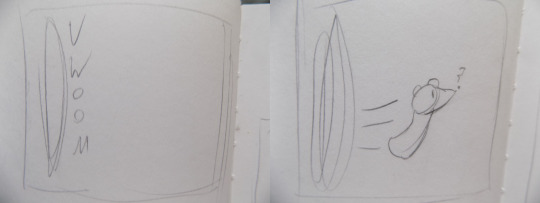
So, this animation “begins” with Guffyn opening a portal in time and arriving into a quiet alleyway in the night. Here Guffyn is rather confused, giving the impression that Guffyn doesn’t really know where it’s going. This was supposed to be the ending shot to the whole animatic, where it loops back to the last frame of the film will mirror the first.
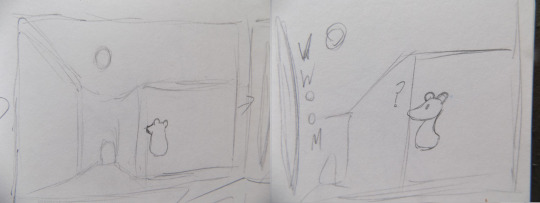
This is where my segment really begins, with Guffyn looking off at the moon for a few seconds before a portal opens to Guffyn’s side with them looking at it in confusion. I always wanted this shot to be the opening shot, have the alleyway there with a little entrance and the moon in the sky.
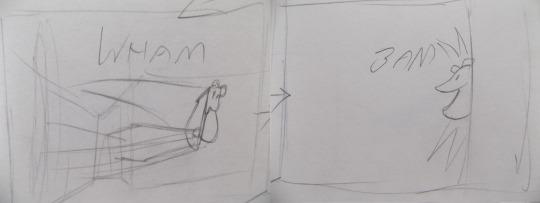
A foot zooms through the portal, hitting Guffyn and slamming them into a wall! This violence was to establish a more urgent tone because who would want to stomp on a small cute creature like Guffyn? Not unless it was absolutely necessary, showing the audience that this character means business.

An aggressive hand came in, grabbing the Guffyn tight causing it to let out a squeak! A huge gun is then pointed in Guffyn’s face, with a closeup of Guffyn’s shock! This was to make Guffyn look that much more innocent and small in comparison to the huge hand and gun.
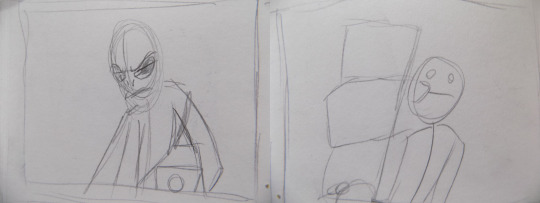
Finally, we see the aggressor, Character A! Not named at the time.
Pointing the gun at Guffyn in a POV shot, we get to see their rather intimidating appearance and are only left with vague answers on who these characters are.
Then, a hardcut to Character B! Taking out some boxes, the designs here are both simple just to block out the scene and what’s happening. We hadn’t finalised any designs or even discussed them before this, so kept it to know what I’m doing. In hindsight, not a fan of how little Character B is actually in this, and so this was changed in the next scripts and storyboards.
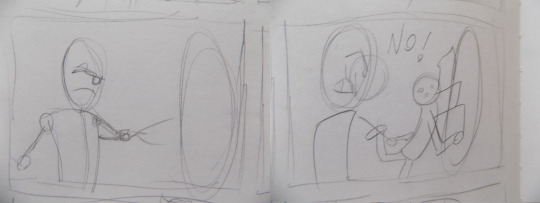
Character A shoots out a portal to take Guffyn back. This establishes the whole narrative of things going wrong when Character B trips up and accidentally stumbles into the portal, much to Character A’s dismay.
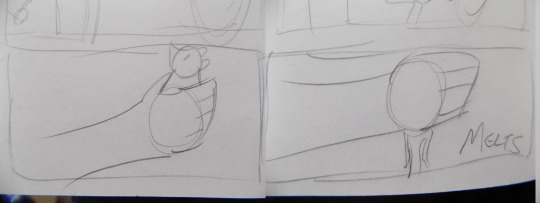
Seeing a chance to escape, Guffyn transforms into liquid and melts out of Character A’s hands.
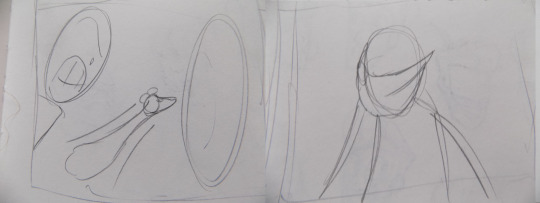
Guffyn then flies into the portal as Character A tries to grab them before they go, but fails... Character A groans saying something like “Not again...”
Summary
This storyboard was a perfect foundation to build upon, the setting was something I really liked and Character A’s reactions where perfect for setting up that there’s more to this story, however this draft has several problems.
My biggest being the portal Guffyn escapes into, would not have been a random dimension as Character A shot the portal, it would have been to go back to the facility which Guffyn had escaped from. Thinking from a story standpoint, Guffyn would have gone back to where he escaped from and Character A would follow, catch them without a chase and also return Character B home without any mad chances between dimensions! This would have also meant that Bee would have to have set her animation in the WTF facility and that wasn’t exactly fair in my opinion.
That was my major problem, but I also didn’t like how Character B hardly interacts and I don’t get a chance to set up Character B’s personality. So, back to the storyboards, I had to find a way where Character B plays just as much of a role in the setup, where Guffyn manages to escape by it’s own rules and an animation that won’t conflict with Bee’s aims and wants in her own segment.
Second Storyboard Draft

So, working on my problems with the first board. This version actually begins with Character B taking out the trash, the same sort of shot of the alleyway with the walls, entrance and moon in the background. Suddenly, a portal opens up that catches his attention.

Guffyn flies out and into the arms of Character B, very fast and conveys the impression that Guffyn is escaping. A small level of urgency established as Guffyn takes comfort in Character B’s arms and we get to see that Character B is a kind and caring character...
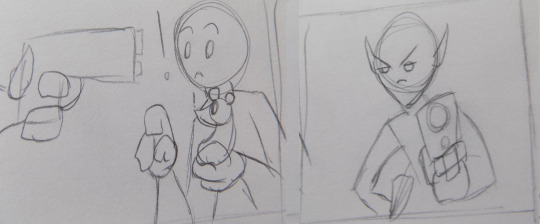
While Character B is preoccupied with Guffyn, a gun points into view which causes them to jump and look up in shock! It’s Character A! Looking all intimidating and menacing while pointing an alien device into Character B’s face! Quietly and calmly telling Character B to let go of the Guffyn...

Character B turns away, claiming that Guffyn is harmless and that it likes him! Character A establishes that Guffyn is actually capable of many things and that it has the capacity to destroy dimensions, not once lowering their gun. Showing how contained and composed they are.
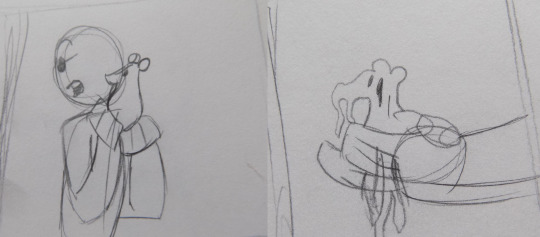
Character B steps back claiming that it might not want to destroy worlds. As they argue, Guffyn melts through Character B’s hands.
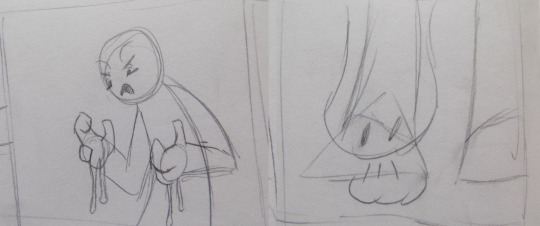
Character B reacts in disgust, letting Guffyn drop to the floor giving it a chance to escape! I’m quite a fan of how I got to keep the melting effect.
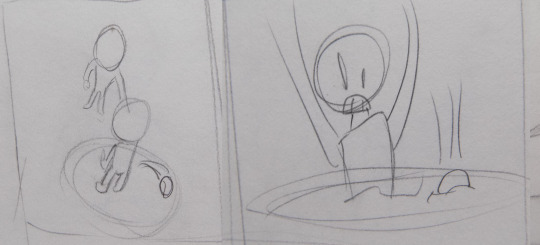
I’d noticed how flat this might have been laid out, so I decided to do this high angle shot to show the portal forming under Character B. Not only to be visually interesting, but to challenge myself by drawing at that angle. It also shows where the portal is formed and also accidentally brings Character B into the adventure!
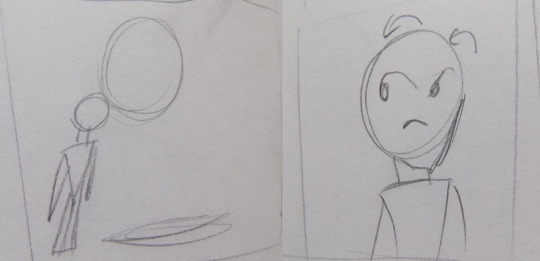
Now alone, Character A reflects on what just happened and simply wonders why their job can’t be easy.
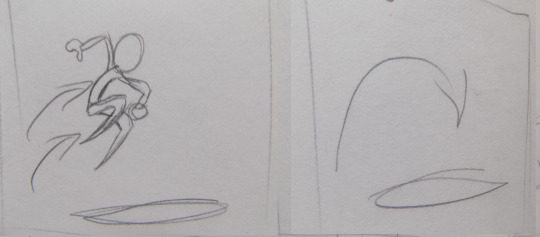
Character A quickly jumps after and my segment ends...
As you can see, it’s almost the same. However, just simply rearranging certain aspects to make a much more refined film. Elements like Character A being left alone and Guffyn melting away to escape. The violence and urgency much more toned down and in a sense reversed, since Guffyn is all cute and cuddly until it’s revealed that Guffyn can be weaponized. Making him more of a threat rather than make him innocent throughout and making Character A the aggressor.
With this rough draft done, I then began to write a script and create a much more refined product.
Script Development
With my new foundations, I began development on the script and storyboards. This time however with my artstyle in mind and something that will be much much closer to a finished product.
When writing the script, I had to keep in mind the character’s personalities. Character A, a headstrong, determined figure that has no time for nonsense.
Character B, a lighthearted and accepting guy that won’t hesitate to show kindness to the most dangerous creatures.
With these attributes in mind, I gave Character B the name, Skip. His last name was going to be Anajump because what I was originally going for was a name based on the phrase, “A hop, skip and a jump away“. But, that wasn’t necessary.
Character A became Vasyl, a name in some languages that means leadership and independence. I felt it was important to give them a foreign sounding name since they are an alien.
When I pitched these ideas forward in the group discussions, nobody seemed to object and the names stuck!
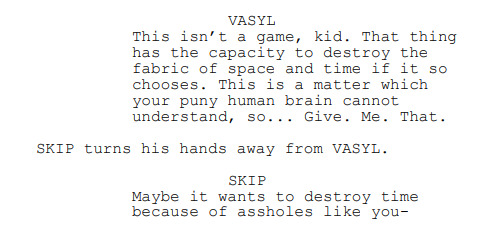
These characters went through a bunch of developments, character-wise and visually. Both Vasyl and Skip had lines where they swore in initial scripts, while it felt in line with Vasyl’s character, it didn’t feel right for Skip, plus it made him less endearing. He just seemed like any old teenager than a kind hearted youth!
Their personalities remained the same, but when the brief asked for a sudden detail to be revealed that changes the dynamic, it definitely got me thinking. A rough idea I came up with was have Vasyl grow a bond with Skip because she knew a relative of his who had died on their adventures, seeing those key traits she saw in them. Specifically in regards to his kindness. And just before they part ways, Vasyl would make a comment like “The boy’s just like you”. This idea was soon shot down as it was a little complicated and to keep characters down to a minimum, I didn’t want to restrict people into including certain details.
Another idea I entertained was Vasyl knowing everything that was going on while Skip had no clue, so when she first appears it’d be like “Not again! No time to explain, follow me!” This didn’t really work for me and I preferred having them meet for the first time.
Storyboard Development
Now I had names, designs and direction for the story to go in. All that was needed was to rebuild my vision and get it more clearly across...
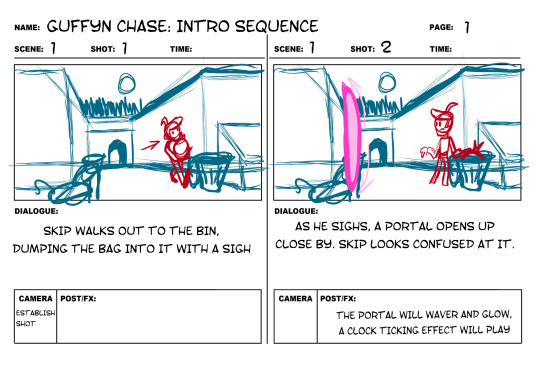
So, we establish that Skip is just a regular human with a regular job in his regular routine. Just having him sigh establishes he is a little bored of his usual life.
Skip’s reaction to the portal opens also establishes that the wacky adventures that he will embark on throughout everyone’s animation would be completely new and mind-boggling to him.

Guffyn flies out, straight into Skip’s arms. Making it seem defenceless and innocent.
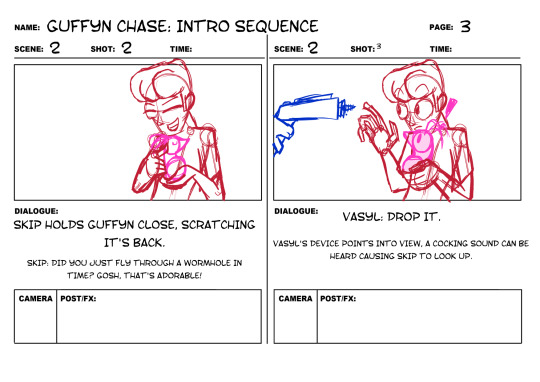
Skip’s reaction to Guffyn is nice, we see his open-mind and kind heart. His and Guffyn’s shock when confronted with a big tall alien woman with an unusual device gives the audience the initial expectation of Vasyl being the antagonist.
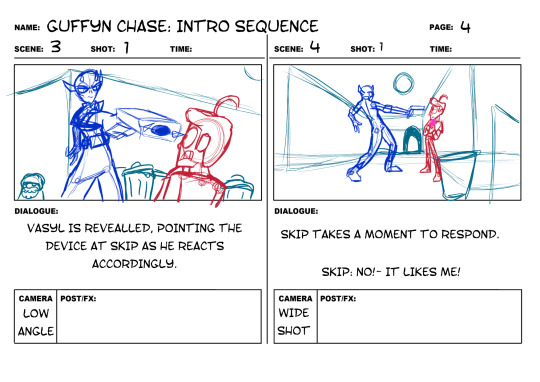
A small pause to let the bizarre-ness sink in, building tension as Skip refuses to answer her. We see Skip takes a few seconds to pluck up the courage to say know.
Vasyl’s gun was changed to look more like a taser and device, make her look like she’s using a tool rather than a weapon.
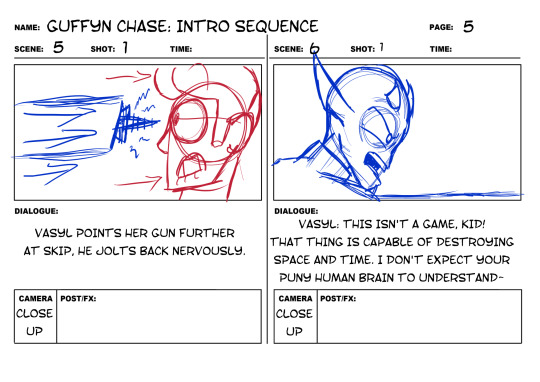
Vasyl’s rant and expression shows the audience that there’s more to Guffyn than it seems, maybe it is not to be trusted.
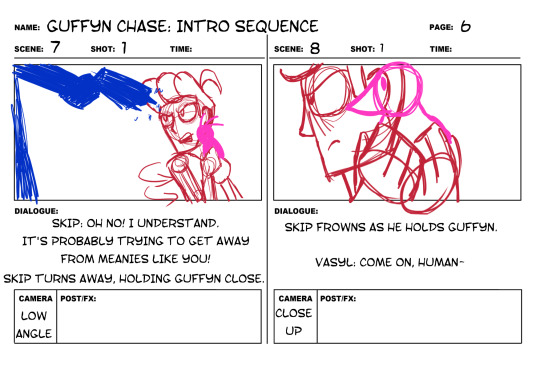
Taking advantage of the situation, Guffyn melts into Skip’s hands in an attempt to sneak away unnoticed. This is set up into the ending of Alex’s animation, where Guffyn takes advantage of the situation to escape.
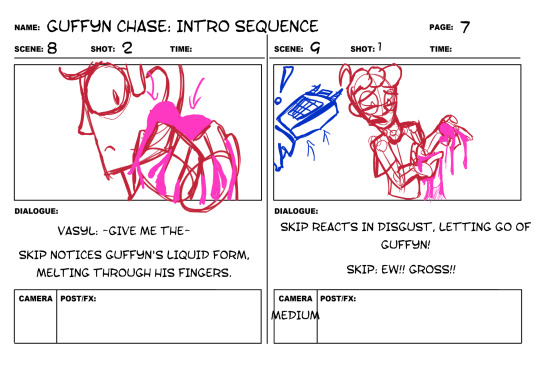
Skip notices Guffyn leaking through his fingers and reacts accordingly! Vasyl jumps back in surprise due to Skip’s sudden recoiling.
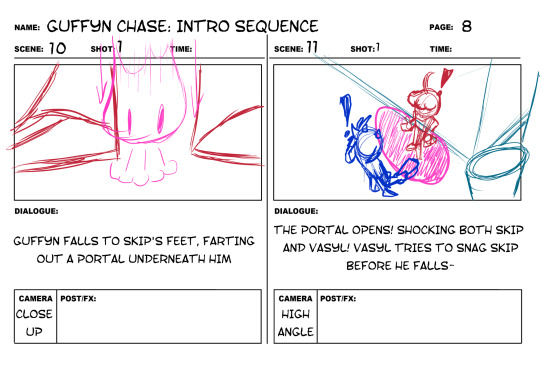
Vasyl’s attempt to save Skip is the start of their alliance, showing the audience that Vasyl doesn’t want to drag innocent lives into her job.

But, alas, Skip falls into the portal. Getting dropped feet first into the conflict, Vasyl can only react in disappointment...
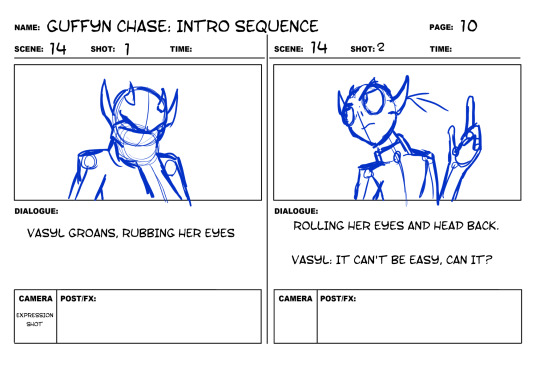
Her casual reaction sets up a drier side to her personality, showing how these unusual situations are a regular occurrence to Vasyl.
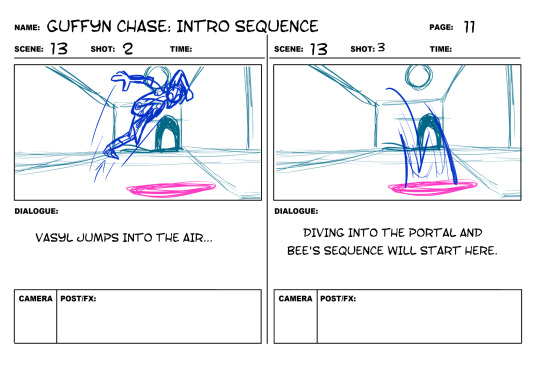
Vasyl jumps in after Skip and straight into Bee’s animation with them falling down. Which further goes onto establish Skip’s kindness and Vasyl’s casual attitude to this situation.
Summary
Being sure in my vision, I simply continued in this direction and made some animatics with test audio. Hardly anything story-based changed from now until my final animation unless it was purely visual. I was really happy with how this turned out and I was even more happy about bringing this to life.
0 notes
Text
War of the Spark Reprints & New Art
I can’t believe we’re already on the brink of Core Set 2020 previews! Before we go there, I”ll wrap up my thoughts on War of the Spark. Today, some reprints & the new art that accompanies them. This is always one of my favorite things, to see how staple cards are reinterpreted in new contexts.
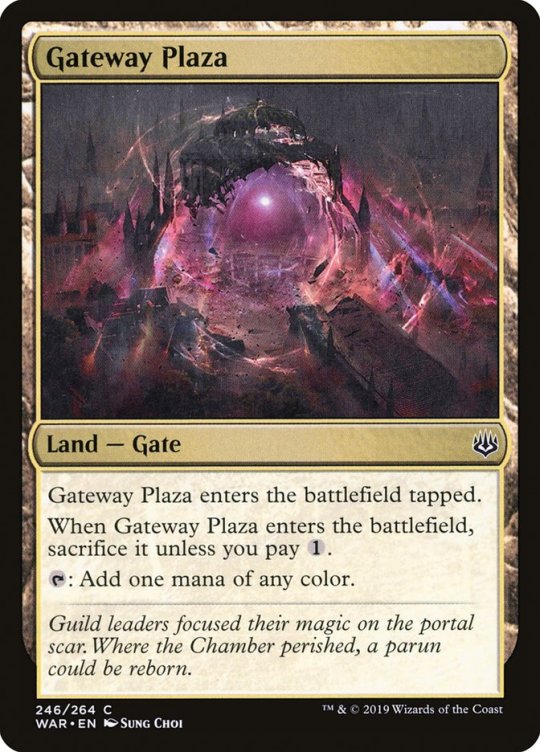
Starting with a bang, so to speak, is this redo of limited staple Gateway Plaza. To me, this was an ingenious design on the part of the creative team. By giving us identical art two sets in a row in Guilds of Ravnica and Ravnica Allegiance, they created a sense of constancy, of permanence on this world. Blowing it up was the most evocative way to start this war, and to make clear the sudden and violent change the plane is to experience. In a set that was somewhat hit or miss on the “war” tone, this was one story moment that was perfectly executed.
Sung Choi has a fairly small pool of Magic art so far, but all of it is excellent. His work first caught my eye with the fantastic Molten Rain reprint in Modern Masters 2017, and recently blew it out of the water with the Ultimate Masters Life from the Loam. This Gateway Plaza does a phenomenal job of conveying this powerful story moment, and is a highlight of the set.
All Versions:
War of the Spark
Guilds of Ravnica/Ravnica Allegiance

Ajani’s Pridemate has been a staple since it was first printed in Magic 2011, and it’s great to see it back here as Ajani’s signature spell, errata and all. The existing version by Svetlin Velinov has been the only version til now, so it’s exciting to see a change.
Sidharth Chaturvedi got 4 cards in War of the Spark, and for good reason. The set has a very animated, comic book style about it, and Sidharth’s style is a perfect fit. He tends towards this illustration-esque feel, with stark but narrow color palettes (basically just blue & yellow here), and a sense of visible brushstrokes. It fits in beautifully with the feel of the set. My only wish is that the setting were a little more visible, putting this in the context of Ravnica, as he did on Pouncing Lynx.
War of the Spark
Magic 2011

Augur is another staple from core sets of yore, and a fantastic reprint for Standard, though I wish we had more context for this character. Who is this merfolk defecting to Bolas, and why? But that’s neither here nor there.
What I love about this depiction is it really conveys the sense of this creature being an oracle or seer of sorts, where the existing artwork is more generic. The water in particular is done amazingly here, conveying the motion surrounding the character while still giving us a perfectly clear view. The colors are beautiful, and the details are precise but not overwhelming. Alex Konstad is excellent, and I love the piece. I’d check out his Coral Commando & promo of Deeproot Champion as examples why it made perfect sense for him to get this commission.
War of the Spark
Magic 2013

Another signature spell that made perfect sense to bring back. As much as I love the original version of this, charging at the viewer, this one is simply phenomenal, and I’m so happy they had Aleksi Briclot do it. He’s done a huge number of Magic cards, going back to the Kamigawa days, and often gets major commissions, including all five of the original Lorwyn Planeswalkers. He does Chandra and fire so phenomenally well. Just look at Stigma Lasher and Ravaging Blaze for a sense of what he can do with fire. And, of course, the original Chandra Nalaar is beyond iconic.
This piece, a Common whose art will often go unnoticed by drafters, shows just how incredible the quality of Magic art is.
War of the Spark
Kaladesh
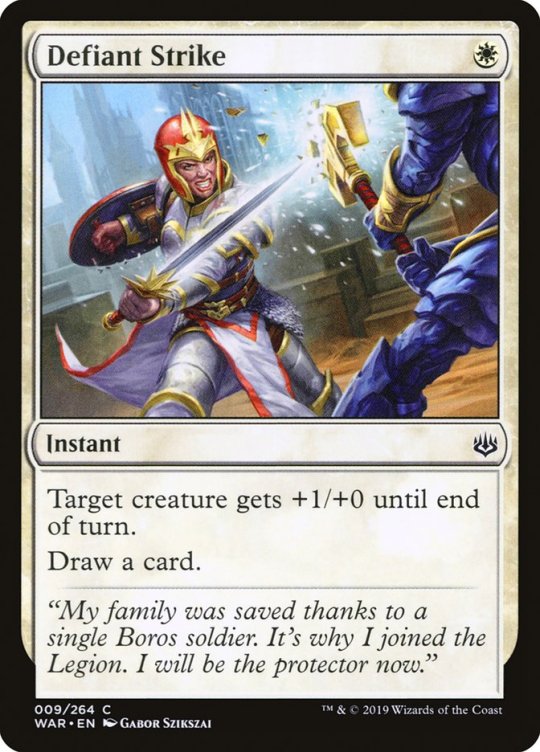
This is one of those spells I always feel like has been around since... I dunno... Tempest or something. But it’s actually only the second time it’s been printed since its debut in Khans of Tarkir. Obviously, the dream is to draft it in the same deck as Feather, the Redeemed, but I’m not sure how often that is actually going to happen. Either way, it’s a fun cantrip & utility trick for Limited.
Gabor Szikszai is great at these action shots, frequently illustrating for the Boros or other combat-oriented individuals. His pieces are full of energy, and always feel like the very apex of the moment, like the shots you’d see on a storyboard or in a comic. This style is a perfect fit for War of the Spark, and this piece does a great job.
War of the Spark
Khans of Tarkir
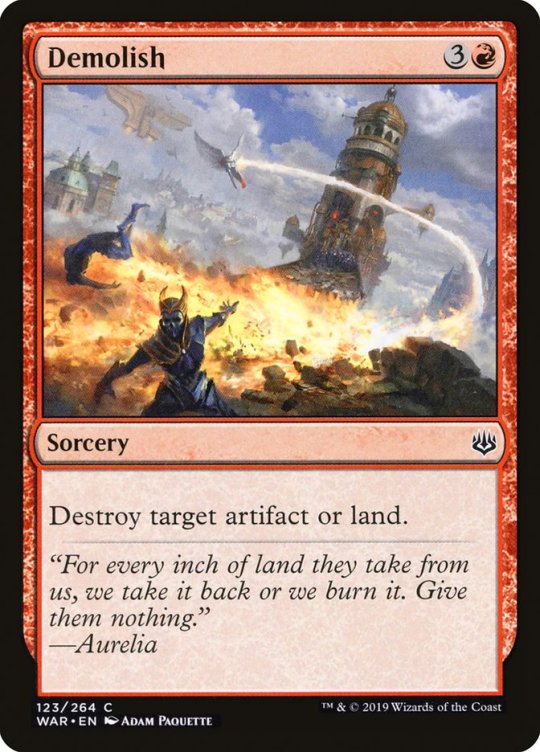
Demolish, on the other hand, has been around for a long time, going back to Odyssey, and it still shows up as a perpetual inclusion. It’s always not good enough for standard, and most of the time it’s not really playable in Limited either. That said, it’s the kind of effect that needs to be around, just to serve as a baseline. Probably its best inclusion, from a Mel perspective, was in Kaladesh, where artifact removal was maindeckable, yet the rate made this far from overpowered.
As for the art, this may be my favorite iteration ever, since it’s possibly the only version ever to actually depict destroying both an artifact and a land, whereas most versions are more typical artifact destruction designs. This also goes deeper, as the building being destroyed is the Interplanar Beacon, first hinted at on Steam Vents in Guilds of Ravnica. The fact that they went to so much effort to seed these important story moments for War of the Spark is above and beyond awesome, and I’d love to see more of this in the future.
Adam Paquette needs no introduction–he’s Magic art royalty at this point. But I would like to point out that he did a huge number of lands for this year on Ravnica, including the aforementioned Interplanar Beacon, another of my favorite pieces from the set, and several of the evocative basic lands. It’s amazing to get to see so many different angles of the same buildings & locations, and was one of the highlights of this incredible year in Magic.
War of the Spark
Ixalan
Kaladesh
Theros
Avacyn Restored
Zendikar
Odyssey

Awwww look at the goodest boy! Mowu is here serving good boy realness, and I’m all about it. I love that they were able to print this spell and use it effectively as a signature spell to demonstrate Jiang Yanggu’s magic. I’m always a little surprised to see this spell reprinting, since it feels like Wizards is perpetually unsure if this is too powerful or not, toying with making this effect cost 2 mana or making it slightly less of a buff for 1. Either way, I’m happy to see it back. Obviously, this card goes back to the genesis of the game, and is one of the only iconic spells from that era that would still be printable these days.
I didn’t immediately recognize Dmitry Burmak’s name on this card, but one cursory glance at his card history and I immediately recognized a number of his pieces. His first Magic pieces were from Unstable, including two of my favorites: Lobe Lobber & Willing Test Subject. On Ravnica, he’s done a bunch of pieces for the Rakdos & Izzet, including Captive Audience, Electrodominance, and Light up the Stage. His pieces have tremendous energy and more than a dash of whimsy, and I am here for it. I’d love to see more of this energy in Magic art going forward.
War of the Spark
Return to Ravnica
Tenth Edition
Ninth Edition
Seventh Edition
Fifth Edition
Ice Age
Alpha

From the very old to the much more recent, New Horizons is one of the increasing number of land ramp enchantments Wizards has been pushing in recent years as an alternative to land fetching. To be clear, these effects have been around for a while, but they’re much more frequent than they used to be, and land fetching doesn’t show up quite as often. It’s a cool effect, and I do like it. I just hope they keep land fetching as well, since both effects are useful in different ways.
Eytan Zana is a name that may not be super familiar, but you’ve definitely seen a ton of his works, and that’s because the vast majority of his Magic artworks are lands. One of my favorite Forests of all time is his, the idyllic deer & stream Forest from Avacyn Restored. It’s his mastery of landscapes that makes this New Horizons art so good. For all intents and purposes, it is a land art, just themed on a spell. I love the subtle ruins of the city in the foreground, and the majesty of the great trees growing out of the main structure are absolutely breathtaking. Well done.
War of the Spark
Ixalan

Ahhh, Primordial Wurm. Herein lies the proof of just how pushed creatures are these days. Back in Alpha, this casting cost got you a 6/4 Craw Wurm. Now it either gets you a 7/6 Primordial Wurm, and it’s still basically unplayable. I look forward to ten years from now, when we get a 10/10 Wurm for this exact casting cost at Common, and it still doesn’t see play.
Anyhoo, this is a fun piece. Svetlin Velinov is another piece of Magic art royalty, who needs absolutely no introduction. What I love about him is the vast array of types of cards he does. Sometimes it’s a high-profile Mythic Legend like Roalesk, Apex Hybrid. Sometimes it’s a goofy limited trick like Maximize Velocity (with goofy Viashino to match). And sometimes it’s an absolutely gorgeous land. But no matter what, his style shows through and makes something totally memorable. I’ll remember this Wurm chasing down bite-sized eternals, even if I forget if it’s a 7/6 or a 6/6 or a 6/4 or whatever the hell size Wurms are these days.
War of the Spark
Dominaria

One only need look at the original version of this art by Karl Kopinski to get a sense of the art direction for this set. What was once a somber, pensive piece is now action, in full comic book mode. And I’m totally here for it. I do love how the Nicol Bolas statue was used as a prop in this set.
Obviously Daarken is a legend. Suffice it to say, he’s done everything, but definitely has a talent for darker, more sinister pieces (and occasionally, the exact opposite). This piece is great, though I will say I don’t quite understand the Nahiri quote on here. I would really have rather seen a Sorin quote here and had them use this one on Nahiri’s Stoneblades. But what do I know?
War of the Spark
Magic 2012
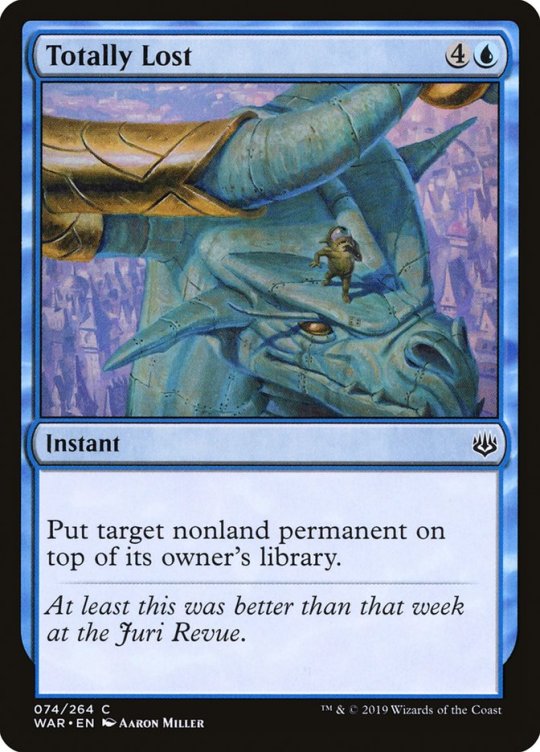
Last but not least, it’s Totally Lost, everyone’s favorite card they wish cost 1 mana less, but couldn’t really without being a little too powerful. Honestly, I love that they brought back Fblthp for this, though if they do it a third time, then they’ll never be able to do a version of this card without him ever. Think about that carefully, Wizards. Probably my favorite thing about this card isn’t even Fblthp on top of the Bolas statue, but actually the flavor text reference to his Easter Egg in Captive Audience from the last set. They really went deep this time around.
Aaron Miller does a huge variety of cards, from high profile works like Ajani, Mentor of Heroes, to cards you probably already forgot existed, like Honed Khopesh. He seems to really enjoy these interesting perspectives, looking up or down at his characters from unique vantage points, and creating stylized pieces that have character, but still fit into the Magic universe. I enjoy that this card made it into the set, and I think this depiction of one of the game’s favorite memes, high over the spires of the city, is a perfect place to close out this post.
War of the Spark
Gatecrash
0 notes
Text
Creating the Screenplay for ‘Monsters’
Introduction
The genre for my ‘Moving Image and Fiction’ film is obviously going to be horror. The atmosphere I want to achieve in Monsters is ‘eeriness’- to evoke an unknown and unseen dread in the audience rather than create a horror film centred on explicit gore. I aim for the plot-twist to be revealed subtly at the end. My other key aim is to create a production that was circular in structure - where the end foreshadowed the beginning - a Groundhog Day in miniature.
Synopses of Screenplay/Storyboard
My screenplay centres on Anna Keswick, a fifteen-year-old who wakes up distressed in the night. She tries to get back to sleep so that they won’t hurt her.
She hears noises and, in terror, she goes into the basement to look and sees various distorted creatures rummaging around the place. Instinct tells Anna to get out, but she attracts attention accidently and the monsters proceed to pounce on her and cause her both physical and mental pain. Anna loses consciousness and perhaps ‘dreams’ what happens next.
We hear that the people responsible for the murder are taken into custody, but we do not find out the killers’ identities since the reporter’s voice is drowned out and moments later, Anna wakes up screaming again, and we see where it started. The screenplay ends before the film progresses much further and constitutes a narrative structure loop.
Structure
Within the screenplay, I subtly reveal that Anna was abused by her family as the film’s twist is having the ‘monsters’ in the basement being unidentified and terrifying and having the reporter’s speech be drowned out when about to describe their relation to Anna. I also show that Anna is trapped in a Groundhog Day loop, where she dreams about waking up in terror, her family killing her, the reporter talking about her death and Anna waking up in terror again, because she is in deep denial that her family are hurting her. I do not make clear whether Anna really wakes from a terrifying dream - where her nightmare is about to become reality, or the dream is repeating in a torturous cycle: as shown by the ending of the screenplay having the same monologue as the beginning.
The reason for this is to give spectators a feeling of unease and add horrifying ambiguity. Anna has had the nightmare many times before, as she goes down into the basement and notes that it is ‘always an attic’ in her dreams and when she wakes up from her “nightmares”, she has bruises that she thinks are from ‘kicking the wall too hard’.
The implied never-ending loop aims to unnerve and confuse the audience, especially as they wonder if Anna has really woken up at the end, or she is still involved in a nightmare. It also helps to reveal the true events behind her subjective experience and perspective against the reality of her situation.
Influences from other short films
When writing my screenplay, I had the short film, La Jetée (1962) in mind: a sequence of eerie, still images linked by voice-over, sound effects and music even though there is going to be live-action filming. I enjoyed the minimalism of La Jetée deliberately limited visual information left space for the voice-over to become a focus of the film and the translation of the screenplay was useful for me to develop my own work (The Script of Chris Marker's La Jetée is at: http://web.ics.purdue.edu/~felluga/sf/ScriptLaJetee.html).
Another short film the script was influenced by was Meshes of the Afternoon (1943) - for its surreal atmosphere, images and its representation of the emotional state of a young woman and how it relates to events in her life. I loved its black and white imagery and its ambiguous tone – why does the woman feel and act as she does? I also echoed the themes of death, loneliness and mental torment in it.
In a different way, I was influenced by About a Girl for its realistic urban settings, speech from the protagonist being spoken as a monologue and the subject matter of a young person attempting to make sense of their frightening reality. A similarity that the screenplays of Monsters and About a Girl have is the innocence of the young female protagonist set against the hopelessness of their situations which is only steadily revealed as the narratives progress. From La Jetée, About a Girl and Meshes of the Afternoon, I borrow into the transcript the dark and tragic tone and the unhappy endings and the theme of life being hopeless for the protagonists - where their comforts are not enough to distract them. It challenges a common trend of mainstream media - of life being happy and unthreatening.
At the end of the screenplay, the ‘monsters’ that harass and kill Anna in her ‘dreams’ are implied to be her abusive family and Anna is in such denial about this possibility, that she is trapped in a “Groundhog Day” loop where she dreams about being killed, yet each time ‘wakes up’ to repeat the process before being able to fully recognise this truth.
In a first draft of the screenplay, I made the plot-twist explicit instead of subtly revealing it: I feel this subtlety gives the final draft of the screenplay an eeriness and ambiguity that earlier drafts did not have, since I was going with the idea of “less is more” and of leaving the spectator more space to make up their own mind. I particularly liked this aspect of Meshes of the Afternoon.
I initially depicted Anna running away from home, while her family and police pursue, as Anna reminisces about her past life and abuse (who she reveals as her parents). She fails to get away in the end and her parents threaten her out of sight of the camera. I felt that this moved too far from Anna’s subjective view and did not avail itself to the visual representations of her face.
The structure of Monsters works in the following way: as in La Jetée, the narrative explains what is happening at any point of the film, since both films use still images (this is my initial plan for the visuals) . Also, as in La Jetée, the images will aim to be dark and surreal and fit the tense mood - something also shared with Meshes of the Afternoon (with representation of death within).
Another influential film that helped me establish the tense, monochrome imagery of Monsters was the David Lynch film Eraserhead, where the boundaries between Henry’s dreams, fantasies and reality are deliberately blurred. This is what I aim to achieve with regard to Anna’s perceptions in Monsters.
Monsters also shares with About a Girl in that the protagonist is a neglected adolescent girl and the film deals with a mature subject matter, along with a dark plot-twist at the end, and the narrative told as a monologue.
The process of writing the screenplay
The images of the “monsters” are to be manipulated within Photoshop to match the mood of the film and the bleak world in which Anna lives. I also think that I might need to create some different imagery (i.e. not Anna’s face) where appropriate if it might help expand the expression within the film, without undermining its minimalist and unresolved qualities. I am thinking of using transparent film footage to overlay on the still images to imply the memories and feelings within Anna’s head.
The narration, sound effects and music are to be synchronised with the still images and live-action filming. I plan to perform the voice-over myself and employ a creepy, childish pitch-shifted voice, using the sound software, Cubase - where the voiceover, music and sound effects can also be edited and mixed – and so the audio could smoothly transition between different sections in a similar way to the images.
The story focuses on the experience of a young woman whose life is being destroyed by forces around her which are out of her control, told with an original filming style. I feel that the visual focus (mostly) on Anna’s face throughout the film (along with live-action filming with some transparent overlap) will make the subtle plot twist stronger and evokes the ‘nothing is scarier’ approach, where the most terrifying details are not depicted but are left to the imaginations of viewers.
In Monsters, there will be a ticking sound effect to confuse the viewer as to whether it was a dream or not. The theme I am focusing on was that Anna is abused by Monsters. The title has a double meaning - humans committing monstrous actions – as well as the more widespread use of the term to mean horrific non-human creatures. There will be a single, eerie and disturbing music track called Choral Build to make the film’s atmosphere tense and sickening and adding continuity to the sequence of both still images and transparency.
Overall, the current process of planning my film is rewarding, and I am learning how challenging it can be to explain visual and thematic.
0 notes
Text
Web series week #6
Fourth drafts of all three episodes are now officially done! all changes from the class feedback session, as well as the final writers meeting later that week, have been implemented and we’re good to start developing our shot-lists with our DOP’s. One major change to the script was that I now added some sound ques of a train gradually approaching during the final scene between Paul and Caleb. The idea is that the impending doom of the speeding train would add a little tension to the scene and help to spur Paul’s character on. I also specified what exactly Paul would be doing during the opening montage; the idea I had was that whatever the montage is for episode one will be ‘mirrored’ in episode 3, only instead with Paul looking like he’s on death row the whole time.
This week we’re also doing our test shoots for our title sequences - something I’m dreading to have to edit as I’m utterly useless at adobe after effects and even the simplest composite shot would take me a lifetime. I must say, off the bat, I was surprised and a little disappointed with just how little our crew had organised things for the shoot. Average Joe’s crew had lighting plans, storyboards, crew roles assigned etc. Grimdustries seemed to just be winging it the whole time. It was frustrating because I knew where our producers and show-runner was coming from - seeing as our entire opening credit sequence is planned to be made up of shots from the show itself and obviously we haven’t filmed anything yet. But still, things could have gone MUCH smoother.
Which brings me to a major concern, casting.
So far our casting director has not done a single thing, there’s been zero movement as far as anyone can tell. And if our casting director isn’t keeping at least the producers up-to-date then that’s a major issue! Ideally we should of had our main characters Paul, Patrick, Charon, Muerte and Caleb cast by now, with only the side characters and extras left. But, since nothing has happened and not one single audition has been booked, we had to use our own crew as stand-ins for the title sequence test shoot.
As director for episode 3, I’ve decided that I will lend a hand with casting - along with our other two directors Keely and Alain - and, whilst I have too much on my plate to take over the process completely, I’ve decided to take the sole responsibility of finding our child actor for Caleb myself. Keely and Alain will find the other cast with the assistance of Casey.
It’s annoying, but we seriously NEED to get things moving, the wrong cast can destroy even the most solid of scripts, and if we don’t at least get a decent actor for our protagonist then we have no show!
0 notes
Text
SUMMARY
A nuclear war breaks out in 1986, expending the world’s entire nuclear arsenal, except for one missile. Two children, Philip Chandler (John Stockwell) and Marlowe Hammer (Michael Dudikoff), are abandoned by their fathers in a fallout shelter cut into the side of a wooded mountain. The pair grow up in the shelter, with 1950s detective fiction and swing music as the guiding force in their learning. Fifteen years later Marlowe succeeds in digging out the cave entrance. The pair give each other haircuts, dress in suits, and go to rejoin the world.

Philip narrates their adventure on their first day out:
My name’s Philip, and this is going to be a yarn about me and my pal, Marlowe. About the day we got out of this shelter and went off into the post-nuclear world. Now, as excited as we were about leaving the shelter, it was still a joint that held fond memories. I mean, it was the only world we’d ever known. Where I practiced my magic, Marlowe, his dancing; where we both dreamed of becoming private eyes, just like the ones we’d read about.
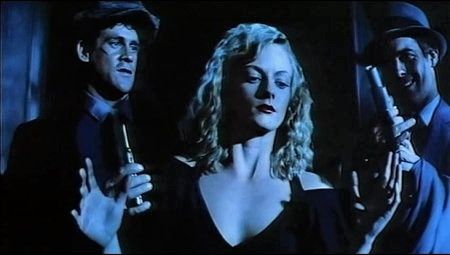
Marlowe hopes to find their fathers, but Philip is disgruntled that they never returned, and presumes that they are dead. The mountain is now devoid of trees. The first people they find are a trio of radiation burned “mutants” chasing a beautiful woman, Miles Archer (Lisa Blount). They rescue Miles, who kisses Marlowe as a distraction and steals his gun. This backfires, as she drops the activation keys to the last nuclear missile. Miles leaves, and the pair are immediately attacked by a biker gang of bald women in red wigs. Afterwards the boys discover the activation keys, which bears their fathers’ names. This excites Marlowe, but disturbs Philip.
They rescue another young woman, Rusty Mars (Michele Little), from a group of armed children Philip nicknames “disco mutants”. She takes a liking to Philip, and leads the two of them to Edge City which is plagued by gang warfare. Rusty takes them to a dance club, where they are captured by cannibals. They want the nuclear keys, and to eat the young men, a rarity of uncontaminated meat. Although Rusty helps them escape and apologises, Philip doesn’t trust her. Just after they part ways the pair meets up with a friend of Miles’ who also wants the keys. After he is dispatched Miles shows up and takes them to her hideout. There she tells them about the purpose of the keys. Miles then threatens to kill them, but they escape.
Rusty has followed them to the hideout, but is attacked by the child gangsters. The pair chase them away, but Philip still doesn’t trust her. He wants to shoot her, but is out of bullets. After Rusty apologises again for lying to him and originally handing him over to the cannibals he says, “That was a million years ago, and I got a short memory. In fact, I don’t even remember who you are”.
The pair resolves to rid the city of the gangs and keep the keys. They go to an abandoned warehouse, using themselves as bait, in the hopes that the gangs will kill each other before killing them. For the most part, the plan works. However, the bosses of the child-gangsters are in fact Philip and Marlowe’s fathers. Before he dies, Philip’s father tells him that the past does not matter. In the end, the only gangster left standing is Miles, who has the keys. She shoots at them, and misses, but startles Marlowe into shooting and killing her.

The film ends with Philip letting go of the angst which he had nursed for 15 years. He adopts Marlowe’s “silver-lining look on life”. The two demonstrate Marlowe’s tap-inspired “post-nuke shuffle” to the crowds of the city. In the closing narration, Philip explains that they plan to set up shop as detectives, but that first he will find Rusty and see if he can repair his relationship with her. Of the keys, he says that he and Marlowe hid them in a secret location, because “you never know, in a tight jam a nuclear missile just might come in handy”.
PRODUCTION
Albert Pyun’s first film, THE SWORD AND THE SORCERER, made box office waves and instantly established him as a hot property in Hollywood. If you haven’t heard much about the young director in the past two years, it’s because Pyun has been busy working on his next feature, a post-nuclear fantasy-adventure tale entitled RADIOACTIVE DREAMS. The film is scheduled for release later this year, though a distribution deal has not yet been finalized.
The long pre-production period was, in part, due to the challenge of acquiring financing (after THE SWORD AND THE SORCERER, Pyun had several offers, but wanted to work independently from the studio system and a six month talent search for the roles of Phillip and Marlowe. Pyun estimates that he saw over 600 young actors, striving to find two who weren’t too modern-looking, and could believably carry a 40’s attitude as part of their characters. During this time, Pyun and Karnowski wrote some 50 drafts of the script, began scouting locations, and dove head-long into the other crucial pre-production elements.
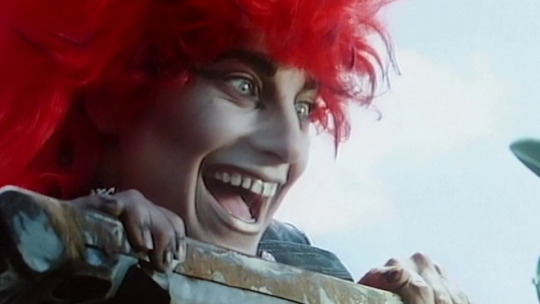
A visit to the production office at Laird International Studios reflects just how much work had already been done on the project which, in Pyun’s words, has a budget only “slightly larger than the $3.5 million spent to film THE SWORD AND THE SORCERER, the walls are covered with color storyboards by in-house illustrator Shawn Joyce (who will be preparing all the film’s matte paintings), character sketches, blueprints of sets, and even tabletop poster board miniatures of the hippie city square (modeled after San Francisco’s Haight-Ashbury district), and the bombshelter (which comes complete with a two-car garage). Mark Moses, a winner of several CLIO awards, serves as the film’s visual consultant, with Chester Kaczenski handling art direction.
Principal photography, by German cinematographer Thomas Mauck, who shot many of Werner Herzog’s films, began in March in Pyun’s native Hawaii, on the island of Hawaii. The remote locations-in the mountains and on the site of the Mauna Loa volcano, where an unexpected eruption occurred on the first day of shooting-generated some visually sensational dallies, according to publicist Scott Fields.
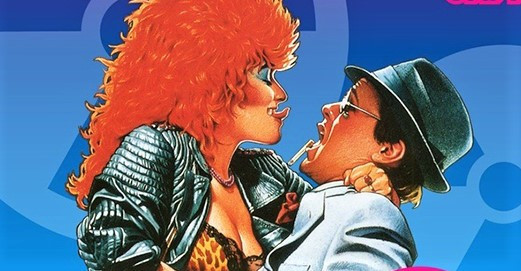
Interview with Albert Pyun
How did you come about writing Radioactive Dreams?
Albert Pyun: I wanted to do something after “The Sword and the Sorcerer” that was distinctive and not like anything else. I think I felt that if I only got to make 2 movies in my life, the second had to be as imaginative as I could create. So that was the start of it and I had a lot of meetings with studios and what they liked about my first film was how it was imaginative, so I went that direction.
Did the 1980’s missile crisis have anything to do with what inspired you?
Albert Pyun: Well, no, but growing up in the Col War years certainly did. I always was a fan of Dr. Strangelove and i think that and “O Lucky Man” got me going on the idea of the last nuke left.
How long did it take for the guys to get the “Post Nuke Shuffle” down?
Albert Pyun: Did they ever?? To be fair, we had to shoot it really fast as the sun was coming up and we were losing extras. So we had to shoot it fast and that was unfair to John and Michael because they did work hard on that dance. We shot most of the big music scenes and extras scenes in one night so that really made it a very rushed shoot night. I don’t know if John was as comfortable with the dance as Michael. I think it went against this sort of “cool” vibe John had. He was very dedicated to what we were doing but some of it i could tell unsettled him.
The dance looked pretty amazing. I’m surprised it isn’t a staple to dance to at weddings and birthdays. Any memories of when you filmed the big final scene?
Albert Pyun: Just how fast we had to do it. I was disappointed we could do it with more takes and shots. It was pretty basic and FAST. And they had a costume change in the middle of it. I had actually shot several book end scenes which were set 40 years later and had a young mutant reporter interviewing Rusty about Philip and Marlowe. It talked about what eventually happened to them and how Marlowe was murdered by a gang trying to get the launch keys and how Phillip left rusty to destroy the keys once and for all but never returned. I think there was a small shot at the end showing Philip and Rusty’s son and a quick peek of Philip watching from afar to keep them safe.
The soundtrack to this film still remains very popular. Did you personalty pick any of the artist that made it into the movie?
Albert Pyun: Yeah, I selected the songs used. My friend and co-producer John Stuckmeyer was into that LA music scene and got a lot of bands to submit cassette tapes of demos. He weeded out the most appropriate ones and he and I selected the final choices to be used. I think we had a couple written for the movie specifically when we couldn’t find exactly what we wanted.
How did you end up meeting John Stockwell and Michael Dudikoff?
Albert Pyun: They came in during the casting process. We saw a lot of great actors of that time, Judge Reinhold, Clancy Brown, Tim Van Patten, Harry Anderson, many really good actors. We even had a breakfast meeting with Tom Hanks, a tape submission from Ellen DeGeneres. All were young and at the start of their careers as was I.

As a special effects makeup artist, I found the mutants completely terrifying! Any memories of the makeup process on the actors?
Albert Pyun: That was by Greg Cannom who would go on to win oscars for Dracula and more. He figured out the design and look. I was disappointed that I had to lose the surfing sequence in the film. We wanted to dye the ocean flourescent orange and have surfing mutants surf and rot I think but the Coastal Commission said no.
Do you think a film like that could be made today?
Albert Pyun: No, Radioactive Dreams wouldn’t get made today. It’s way too eccentric and weird. Even in 1984 it was tough to get made. I raised the budget myself from a single investor. He was a real estate developer in San Bernadino California. I think he did it because he finally gave in to my dogged persistence for over a year. He said “no” many times, but I kept hearing “yes”. I’m an optimist I guess. I believed in the film and knew it would be a unique picture to follow up The Sword and the Sorcerer. Anyway halfway through production the funding disappeared.
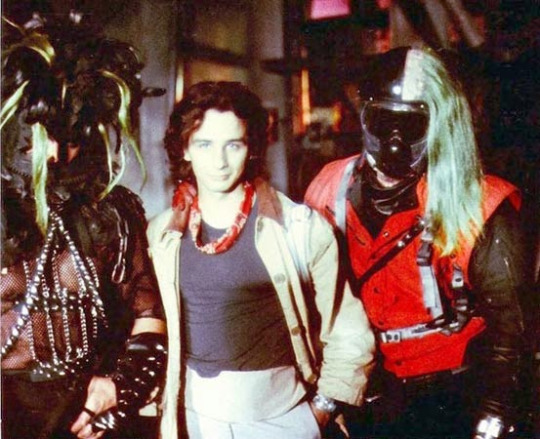
A couple of Edge City’s best and brightest with costume designer Joseph Porro
SPECIAL EFFECTS
Special prosthetic make-ups were created by Greg Cannom. His bizarre designs range from the mysterious repulse men to a wrinkled surf bunny (a girl whose excessive bathing in the post nuclear sun has given her the appearance of a 90 year-old woman) and his favorite, the mutant surfers: those who refused to give up their treasured pastime, even though the ocean has become radioactive.
The surfers’ skin, hanging loosely from their bones, is riddled with chemotherapy patches and permanently-affixed barnacles. their long. scorched, platinum blonde hair is missing entire sections. Josephine Turner, who did the intricate hair ventilating for THE HOWLING and THE INCREDIBLE SHRINKING WOMAN, will create the wigs. Straight and extra make-ups will be provided by Ve Neil and Rick Schwartı.

Mutant Surfer
Special fire and mechanical effects will be handled by Joe Lombardi’s Special Effects Unlimited. The film’s extensive stunt work, under the direction of Alan Gibbs offers several cliff-hanging sequences: a chase on winding mountain roads involving female bikers, a high-speed helicopter pursuit, various gun battles and a warehouse explosion. Additionally, there will be a surfing sequence in a ‘radioactive’ ocean-a portion of the real ocean near the shoreline will be chemically dyed expressly for filming.
Cast and crew spent most of their final week of production in Los Angeles, working with a 14-foot high mechanical rat created by Charles and Steven Chiodo, with 22 separate functions and 12 operators-giving it head, arm, and body movement capabilities-said to be the most advanced pneumatically controlled robot ever constructed for a motion picture. Star Lisa Blount does a scene while standing in the rat’s mouth. Her stunt double Andre Gibbs, wife of the film’s stunt coordinator Alan Gibbs, takes over for Blount’s death scene in which she is eaten alive by the rat.
This slideshow requires JavaScript.
Radioactive Dreams (1985) Soundtrack
Most of the songs featured in the film are pop rock in the new wave vein. The exceptions are Zim Bim Zowie, a swing number, and also a tune in the American Songbook style, Daddy’s Gonna Boogie Tonight, played on a phonograph during the scene when Philip and Marlowe prepare to leave the fallout shelter. The latter and another track called All Talk were left out of the Australian and German soundtrack releases.[7]
youtube
Nightmare – Jill Jaxx – 5:10
Radioactive Dreams – Sue Saad – 5:18
She’ll Burn You – Maureen Steele – 4:13
Young Thing – Cherri Delight – 4:09
Tickin’ Of The Clock – The Monte Carlos – 2:07
Psychedelic Man – Shari Saba – 2:41
Eat You Alive – Lisa Lee – 2:40
Guilty Pleasures – Sue Saad – 3:44 (Performed by Saad on-screen)
Turn Away – Mary Ellen Quinn – 2:13
She’s A Fire – Sue Saad – 2:07
When Lightning Strikes – Sue Saad – 6:51
Zim Bim Zowie – Darryl Phinessee – 2:20
Daddy’s Gonna Boogie Tonight B.J. Ward
All Talk Lynn Carey
CAST/CREW
Directed Albert Pyun
Produced Moctesuma Esparza
Written Albert Pyun
John Stockwell – Phillip Chandler
Michael Dudikoff – Marlowe Hammer
Michele Little – Rusty Mars
Lisa Blount – Miles Archer
Don Murray – Dash Hammer
George Kennedy – Spade Chandler
Norbert Weisser – Sternwood
Christian Andrews – Brick Bardo
Paul Keller Galan – Chester (as P.K. Galán)
Demian Slade – Harold
Hilary Shepard – Biker Leader (as Hilary Shapiro)
Sue Saad – Punk District Singer
Kimberly McKillip – Sadie – Hippie Chick
Gulcin Gilbert – Greaser Chick (as Gulshin Gilbert)
Mark Brown – Greaser
Russell Price – Greaser
Makeup Department
Greg Cannom … special makeup
Ve Neill … makeup designer
Brian Wade … additional makeup effects designer / additional makeup effects supervisor / special makeup effects artist
Kevin Yagher … prosthetic makeup assistant
CREDITS/REFERENCES/SOURCES/BIBLIOGRAPHY
Cinefantastique v15n01
La Cosa Cine Fantastico Issue #113, July, 2005
staystillreviews
Radioactive Dreams (1985) Retrospective SUMMARY A nuclear war breaks out in 1986, expending the world's entire nuclear arsenal, except for one missile.
0 notes